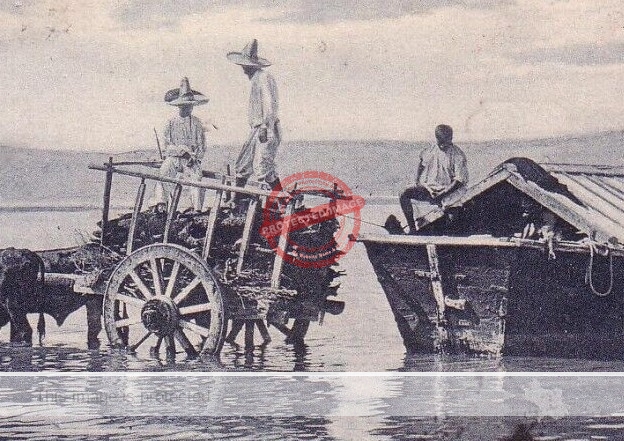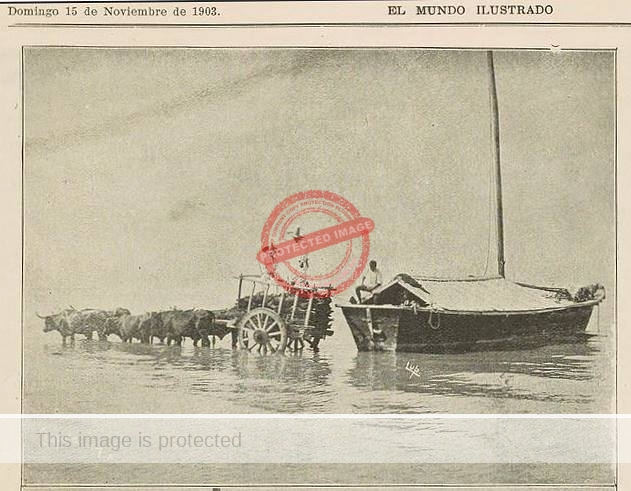This is the fourth in a mini series looking at examples of photo identification and interpretation errors related to the Lake Chapala area. In his article in the February 2025 issue of Estudios Jalisciences, Dr. Juan Arturo Camacho Becerra included this photograph, taken at Lake Chapala by Guadalajara-based photographer José María Lupercio. It was not the photograph itself, but the author’s interpretation of the photograph, that caught my eye.
The image was first published in El Mundo Ilustrado in 1903, and was later reproduced, slightly cropped, as a postcard in a series published by M. Hernández. I included the postcard version as Figure 2.5 in Lake Chapala: a postcard history.

Fig. 1 of article by Juan Arturo Camacho Becerra in Estudios Jaliscienses #139. Note that, despite the caption, this must be Lake Chapala, not a river.
The interpretation given by Dr. Camacho on page 29 of his article is as follows:
The image is very revealing as to the technology of towing, since as early as 1868 steamboats were operating, making trips across the lake and touching various points. The railroad arrived in Guadalajara in 1888, so in this image, a primitive technology for towing canoas is still shown. From the photographer’s point of view, it seems to be near the shore, and the cart’s momentum will allow it to be launched into navigation. The photograph also gives us a visual testimony of the main activity on the lake at that time: fishing.” [The original Spanish text is given at the end of this post]
In my opinion, the photograph fails to support this interpretation. The idea that canoas (‘sail canoes’) were launched by being towed by cart into the lake is not found in contemporaneous descriptions, and would be extremely inefficient. If canoas were launched by being towed, then why have a cart at all? It would be far more effective to simply have oxen (or other beasts of burden) pull the boat direct.
Fishing was a major activity on the lake. But this canoa is most definitely not a fishing vessel, and the photograph offers no evidence related to fishing. Fishing canoas were open, in order to make it easy to handle nets and catch. Covered canoas—such as the one in Lupercio’s superb photograph—were cargo vessels, used to transport goods and produce (and sometimes passengers) from one lakeside village to the next.
A closer look at the photograph strongly suggests that this particular canoa has brought a load of wood, which is being offloaded into the cart in the shallows of the lake. This activity actually ties in very closely with Dr. Camacho’s reference to steamboats on the lake. Wood fueled the boilers which powered the steamboats and their large paddles. On average, sternwheelers burned about two cords (256 cubic feet) of wood an hour while traversing the lake, so piles of wood were stacked at strategic points on beaches around the lake to ensure that fuel was always readily available along their routes. The cart in the photograph may well be transporting wood to one of these woodpiles. But there are some alternative possibilities, since large quantities of firewood were also required at that time to fuel the lime kilns working in many villages, and for domestic use, primarily in kitchens. (I consider this in more detail in Lake Chapala: a postcard history.)

Detail from the Hernández postcard of Lupercio’s photograph.
This is why, I captioned the version of this photograph in Lake Chapala: a postcard history, as follows:
“Transferring cargo from sail canoe to cart, c. 1906. J. M. Lupercio; M. Hernández. A team of oxen waits patiently for a heavy cargo (perhaps wood) to be unloaded from a large, covered sail canoe (canoa). A cart this size could carry about one cord of wood (128 cubic feet).”
It is apparent from his article, which includes several other less serious factual errors and questionable interpretations relating to the history of Chapala, that Dr. Camacho is, unfortunately, unfamiliar with my own research and writing. I am happy to discuss this further, with him or anyone, via comments or email.

Photo by José María Lupercio (El Mundo Ilustrado, 15 November 1903)
Original Spanish text:
“La imagen es muy reveladora en cuanto a la tecnología de arrastre, ya desde 1868 circulaban vaporetos que hacían travesías por el lago tocando diversos puntos. El ferrocarril llegó a Guadalajara en 1888, de manera que en esta imagen todavía se muestra una tecnología primitiva para el arrastre de canoas, desde el punto de vista del fotógrafo parece estar en las orillas y el impulso de la carreta permitirá botarla a la navegación. La fotografía también nos presenta un testimonio visual de la entonces principal actividad del lago: la pesca.” (Juan Arturo Camacho Becerra, 2025, página 29)
Source
- Juan Arturo Camacho Becerra. 2025. “Gente de cercanías. El retrato del pueblo en los alrededores de Guadalajara durante el porfiriato,” pp 24-42, in Estudios Jalisciences # 139 (Febrero de 2025).
My 2022 book Lake Chapala: A Postcard History uses reproductions of more than 150 vintage postcards to tell the incredible story of how Lake Chapala became an international tourist and retirement center.
Comments, corrections or additional material welcome, whether via comments feature or email.